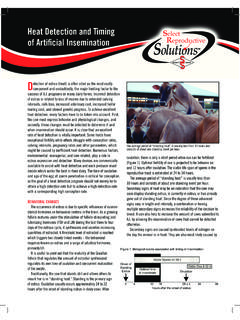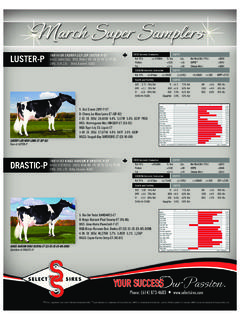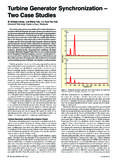Transcription of A Reproductive Management Tool - selectsires.com
1 Estrus synchronization :A Reproductive Management Tool In contrast, many estrus synchronization protocols can induce 70 to 90 percent of the cycling cows and as many as 50 percent of the anestrous cows to display a fertile estrus within a fi ve day period. With conception rates equal or greater than those of natural heats, it is typical for many synchronization protocols to result in 45 to 55 percent of the herd pregnant by the end of the fi rst week of the breeding season (Figure 1). Several fi xed-time options are available that result in 50 percent or more of the herd pregnant following a single day of breeding with zero hours spent for heat detection. Detected in EstrusConception RatePregnancy Rate753365654921 With SynchronizationWithout Synchronization0%20%40%60%80%100% Figure 1. Percent of cows expected to be pregnant after fi rst week of the breeding season.
2 Cows that cycle early in the breeding season will have three opportunities to conceive during an eight week breeding season, compared to only two chances for cows that do not show heat until after the second week. In addition, even in the best Management scenarios, fi rst-calf heifers can be diffi cult to settle. Breeding virgin heifers to proven, calving ease sires three weeks prior to the cow herd reduces the incidence of costly calving problems and allows additional recovery time before the next breeding season. Also, when heifers calve during a short synchronized calving season, it is easy to provide labor to assist with diffi cult births and reduce the incidence of early calf mortality. Most of the economic benefi ts of estrus synchronization are a function of improved Reproductive performance. In reality, the economic benefi ts available through alone pale in comparison to the return on investment when estrus synchronization and are used together as a Reproductive Management tool.
3 ESTRUS synchronization PROTOCOLS The following list of synchronization protocols highlights the most popular systems presently recommended for use in The primary factor affecting the profi tability of any animal-breeding enterprise is reproduction. Other than nutrition, the most powerful tool at the beef producer s disposal to signifi cantly impact Reproductive performance is estrus synchronization . Although historically promoted as a labor saving tool for those producers who want to capitalize on the superior genetics available through artifi cial insemination, many producers have come to realize that the greatest economic returns from estrus synchronization are a result of more timely and effi cient Reproductive Management . The basics of beef cattle Reproductive Management dictate that cows are bred during a defi ned breeding season.
4 This allows calving to occur when the weather is conducive to high rates of calf survival. Controlling the time of calving is also important to match the seasonal availability of grass and forage with the peak lactation demands imposed by the growing calf. Not only is it important to maintain short breeding and calving seasons, but it is also extremely important that a high percentage of the herd conceives early in the breeding require time to recover from the stress of calving before they can be expected to rebreed. Cows that calve early will have more days postpartum when the next breeding season begins, and will be more likely to have resumed normal estrous cycles and fertility. Once a cow calves late, she will be short postpartum when the next breeding season begins and predisposed to reduced fertility. Not only does estrus synchronization facilitate early conception in the cycling cows, but many protocols are also therapeutic treatments to jump-start cyclicity in these late-calving or anestrous cows.
5 Cows that calve early will produce calves that weigh more at weaning simply because they are older. At lb/day of calf growth x $ , each day older a calf is at weaning means an additional $ in your pocket. A calf conceived on the fi rst day of a 60-day breeding season will be worth $ more than one conceived on the last day. Replacement heifers kept from early calving cows will be older at the beginning of their fi rst breeding season and more likely to have reached puberty and targeted breeding weights. Without synchronization , only one third of the cycling animals can be expected to display estrus during the fi rst week of the breeding season. Whether inseminated naturally or artifi cially, only 65 to 70 percent can be expected to conceive to a given insemination. Therefore, after a week of breeding to natural heats, no more than 23 percent of the eligible animals can be expected to be pregnant.
6 Considering the fact that even in well-managed herds as many as 25 to 50 percent of the cows will not be cycling at the beginning of the breeding season, this estimate is very generous. Continued on back cows and heifers. Depending on Management needs, desires and capabilities, there is considerable fl exibility in the choice of systems ranging from exclusive estrus detection programs to 100 percent timed and several options that combine estrus detection and timed In many cases, a common synchronization protocol can be used with several different insemination options. It is very important to note that some systems recommended for cows are NOT recommended for heifers and vice versa. Be sure you appropriately match the synchronization system to the cattle, your facilities, and your detection based programs Although there are several heat detection based options available, these protocols are generally only recommended in rare instances where considerable labor is available, the quality of estrus detection is excellent, and the level of herd cyclicity is extremely high.
7 This typically only applies to small herds of virgin heifers. Heat detection based options are seldom recommended for suckled beef cows because many will respond to treatment but may fail to display estrus. Programs that incorporate timed will generate pregnancies in these cows that otherwise would not have been inseminated. options In general, fi xed-time options eliminate labor requirements for estrus detection allowing all cows to be inseminated at a predetermined fi xed-time. Historically, fi xed-time options have yielded somewhat variable results due in part to varying level of cyclicity among herds and perhaps poor timing of in relation to ovulation among some animals. However, through enhanced follicular control and induction of cyclicity, recent research has yielded timed options with much greater consistency than prior technologies.
8 In particular the CO-Synch CIDR for cows and the CIDR-Select for heifers are most often resulting in fi xed-time conception rates in excess of 50 percent and often in excess of 60 Detection and Timed Programs that combine timed and estrus detection will likely yield slightly greater and more consistent conception and pregnancy rates over the long run. However, because these systems use both estrus detection and timed , the costs and/or labor will tend to be higher and in many scenarios the conception advantage (if any) may be insuffi ciently small to offset the cost. These combined programs are good options if herd cyclicity is in question. Based on estrus response prior to the fi xed time , producers have the fl exibility to abort the timed portion saving on semen cost. Additionally, the combination options are a good choice when extremely expensive/limited supply semen is being used.
9 The more valuable semen can be used in the higher conception cows that display estrus and less valuable semen can be used in females that fail to show estrus and are bred by timed TIPS TO MAXIMIZE SUCCESSN utrition The major factor affecting the success of any estrus synchronization protocol is the percentage of animals cycling at the initiation of treatment. The single most important factor affecting cyclicity is nutrition. Feed cows to achieve a moderate or better body condition score by the time of calving and increase energy levels in rations to minimize the body condition loss after calving. Body condition score your cows regularly to ensure that your nutrition program is allowing for optimum Reproductive performance in your Health Work with your veterinarian to maintain an intensive herd health and vaccination program that addresses all diseases of relevant concern to your geographic region.
10 Perform all vaccinations at least three weeks ahead of the synchronization and breeding period to provide ample time for the immune system to respond and provide protection from the disease in question. Bull Exposure Exposure of females to bulls in the early postpartum period has been shown to decrease the number of days to the fi rst postpartum ovulation and to increase the percentage of cows cycling at the beginning of the breeding season. Bulls should be surgically altered to prevent insemination and disease transmission. Androgenized females also have a biostimulatory effect equal to that of bulls and are inexpensive to produce. Calf Removal The suckling stimulus of a nursing calf extends the duration of postpartum anestrus in cattle. While not commonly practiced, early weaning of calves provides an excellent means to improve the cycling status of the average beef herd.









